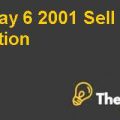
Joyner Lumber Company, Inc.
Company Background:
JLC was founded by R. Tom Joyner, Jr. in 1952 by purchasing Elwell Lumber and Supply Company of Lake Charles. The company is located in the northern outskirts of Lake Charles. The operations and growth of the company are financed by the owner’s own funds. The founder of the company, R. Tom Joyner Jr., died in 1990 and his son R. Tom Joyner III took control. The management of the company is headed by Tom as a CEO and President of the company with main management personnel like Executive Vice President working under him who also deals in purchasing raw material. Other key personnel of the company include VC Accounting, VC President Collection, VC Operations and VC Sales.
The main focus of the company since 1970s has been in the home-building industry, which increased the wholesale business and also contributed significantly to the profitability of the company. Since Tom has took over the company after the death of his father he tried to diversify the scope of the business by entering the commercial and industrial construction business and also the Walk-in retail trade.
After the Death of his father when Tom took control of the company he reorganized the administrative structure and realigned the authorities and responsibilities of the management to increase the operational efficiency and enhance the decision making-process. The recent strategy to diverse the operations of the company is also undertaken to get into the commercial and industrial construction. The main competitors of the company are the regional chains stores who have established the local presence.
The main factors that affect the performance of the company are the fluctuations in the prices of oil, which has the ability to create favorable and unfavorable climate for the company. Economical factors of the company and industry also affect the performance of the company like recession.
Historical Performance of the Company:
The financial performance of the company has mixed trends over the past five years.
Profitability Position:
The profitability ratios of the company are used to assess the ability to generate earnings as compared to the expenses and other relevant costs, which are incurred during the period.
The fixed asset turnover of the company has increased as compared to the previous years, which shows that the company has generated more revenue from its fixed asset as compared to the last year, however the performance of the company as compared to the industry is still very low.
The total asset turnover of the company is constant with very low variation during the last five year period,which shows that revenues generated by the company relative to its asset have very low variation however; the company’s ratio compared to industry is still low.
The gross profit margin of the company also has little variation over the five year period, which is high as compared to the gross profit margin of the industry. Operating profit margin of the company is relatively lower than the industry margin, which shows that the company will have to control its expenses to increase their operating profit. The net profit margin of the company has mixed trends because of the sales of the assets, which increased the margins in few years.
Liquidity Position:
The liquidity position of the company is its ability to pay off its short term obligations. High value of the ratios shows that the company has the larger margin of safety and it possesses to cover the short term debts......................
This is just a sample partial case solution. Please place the order on the website to order your own originally done case solution.













